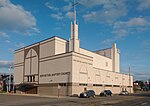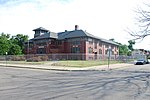1967 Detroit riot

The 1967 Detroit riot, also known as the 12th Street Riot, was the bloodiest of the urban riots in the United States during the "Long, hot summer of 1967". Composed mainly of confrontations between black residents and the Detroit Police Department, it began in the early morning hours of Sunday July 23, 1967, in Detroit, Michigan. The precipitating event was a police raid of an unlicensed, after-hours bar, known as a blind pig, on the city's Near West Side. It exploded into one of the deadliest and most destructive social insurgences in American history, lasting five days and surpassing the scale of Detroit's 1943 race riot 24 years earlier. Governor George W. Romney ordered the Michigan Army National Guard into Detroit to help end the disturbance. President Lyndon B. Johnson sent in the United States Army's 82nd and 101st Airborne divisions. The riot resulted in 43 deaths, 1,189 injured, over 7,200 arrests, and more than 400 buildings destroyed. The scale of the riot was the worst in the United States since the 1863 New York City draft riots during the American Civil War, and it was not surpassed until the 1992 Los Angeles riots 25 years later. The riot was prominently featured in the news media, with live television coverage, extensive newspaper reporting, and extensive stories in Time and Life magazines. The staff of the Detroit Free Press won the 1968 Pulitzer Prize for general local reporting for its coverage. Canadian folk singer Gordon Lightfoot wrote and recorded the song "Black Day in July", which recounts these events, for his 1968 album Did She Mention My Name?. The song was subsequently banned by radio stations in 30 American states. "Black Day in July" was later covered by The Tragically Hip on the 2003 anthology Beautiful: A Tribute to Gordon Lightfoot.
Excerpt from the Wikipedia article 1967 Detroit riot (License: CC BY-SA 3.0, Authors, Images).1967 Detroit riot
Clairmount Street, Detroit New Center
Geographical coordinates (GPS) Address Nearby Places Show on map
Geographical coordinates (GPS)
| Latitude | Longitude |
|---|---|
| N 42.376388888889 ° | E -83.099444444444 ° |
Address
Clairmount Street 1901
48206 Detroit, New Center
Michigan, United States
Open on Google Maps







